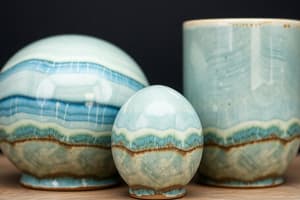Podcast
Questions and Answers
What is the primary function of inorganic pigments in daily life?
What is the primary function of inorganic pigments in daily life?
- To manufacture clay ceramics
- To provide a source of energy
- To create a chemical reaction
- To beautify and differentiate objects (correct)
When did the industrial manufacture of inorganic pigments based on chemical and physical knowledge start?
When did the industrial manufacture of inorganic pigments based on chemical and physical knowledge start?
- 1800 (correct)
- 1500
- 2000
- 1900
What is the definition of a pigment?
What is the definition of a pigment?
- A solid used to create a chemical reaction
- A gas used to beautify objects
- A powder used to add color or change visual appearance (correct)
- A liquid used to add color
What is the primary area of application of Titanium Dioxide pigments?
What is the primary area of application of Titanium Dioxide pigments?
What is the significance of the 19th and 20th centuries in the development of inorganic pigments?
What is the significance of the 19th and 20th centuries in the development of inorganic pigments?
What is the general term for the physical and chemical processes related to the manufacturing of clay ceramics?
What is the general term for the physical and chemical processes related to the manufacturing of clay ceramics?
What factor is most crucial in determining the color impression of a pigment in a given application?
What factor is most crucial in determining the color impression of a pigment in a given application?
What is the primary method of producing inorganic pigments on an industrial scale?
What is the primary method of producing inorganic pigments on an industrial scale?
What drove the development of new color-imparting products in the nineteenth century?
What drove the development of new color-imparting products in the nineteenth century?
What is the result of chemical processes in the production of colorants?
What is the result of chemical processes in the production of colorants?
What is the primary advantage of modern inorganic pigments?
What is the primary advantage of modern inorganic pigments?
What is the scale of production for modern inorganic pigments?
What is the scale of production for modern inorganic pigments?
What is a critical factor in determining the optical properties of a pigmented system?
What is a critical factor in determining the optical properties of a pigmented system?
What is the smallest individual unit of a pigment or powder in general?
What is the smallest individual unit of a pigment or powder in general?
Which of the following can vary to a great extent in pigmented systems?
Which of the following can vary to a great extent in pigmented systems?
What is an example of a typical unit of a particle in pigments?
What is an example of a typical unit of a particle in pigments?
Which of the following properties of the application medium affects the optical properties of a pigmented system?
Which of the following properties of the application medium affects the optical properties of a pigmented system?
What is the primary factor that affects the appearance of pigments?
What is the primary factor that affects the appearance of pigments?
What is the typical range of the visible spectrum in nanometers?
What is the typical range of the visible spectrum in nanometers?
What is the origin of the color in colored pigments?
What is the origin of the color in colored pigments?
What is considered a standard for white light?
What is considered a standard for white light?
Why must color spaces specify their light source?
Why must color spaces specify their light source?
What is the primary difference between pigments and dyes?
What is the primary difference between pigments and dyes?
What is the composition of ochre?
What is the composition of ochre?
What is the primary mineral composition of lapis lazuli?
What is the primary mineral composition of lapis lazuli?
What is the historical significance of minerals as colorants?
What is the historical significance of minerals as colorants?
What is the origin of raw sienna and burnt sienna?
What is the origin of raw sienna and burnt sienna?
What did chemists create based on the original pigments?
What did chemists create based on the original pigments?
Flashcards are hidden until you start studying




